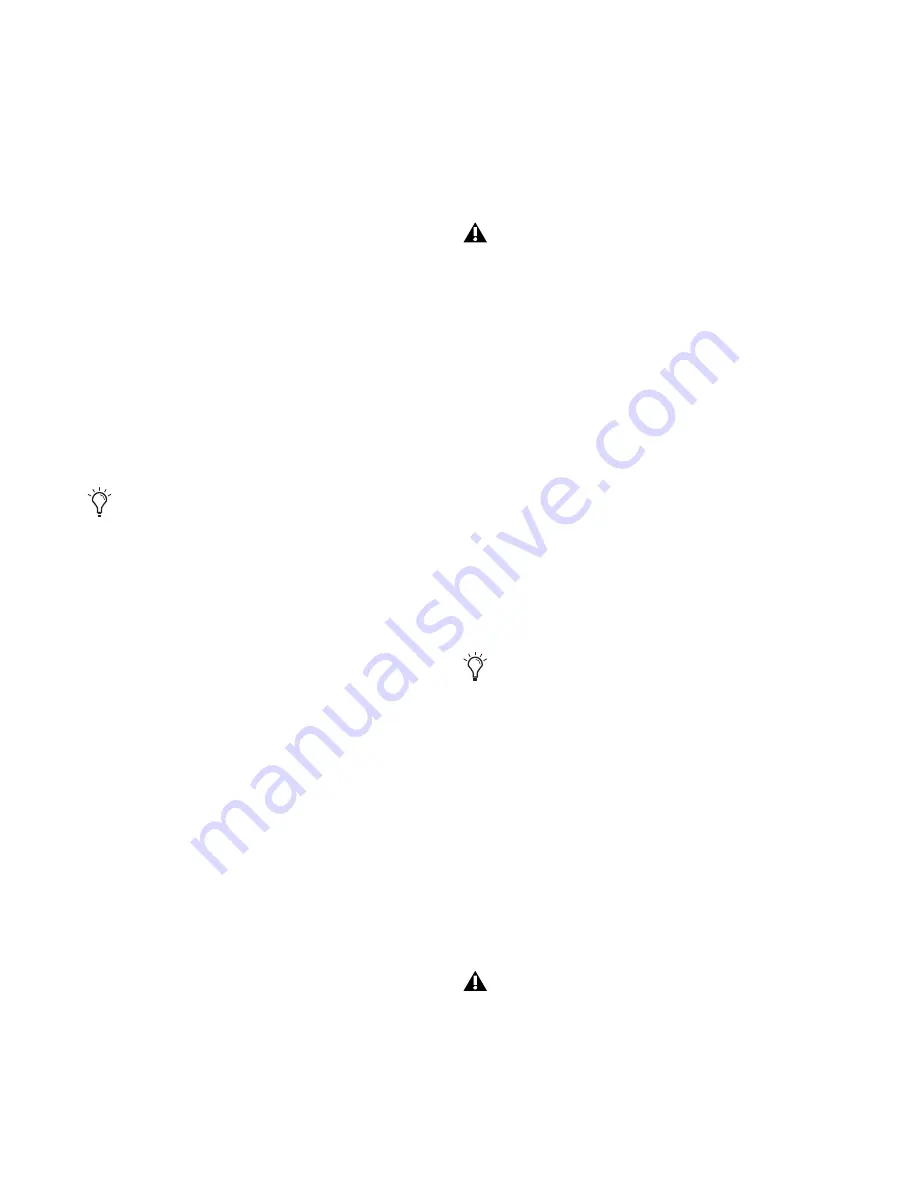
Pro Tools Reference Guide
354
Normal (Nondestructive) Record Mode
In Normal, Nondestructive Record mode,
Pro Tools records audio nondestructively, which
means that if you record over a track’s existing
regions, the audio is not erased from your hard
drive. Both the new and old audio files remain
on your hard drive, available as regions from the
Region List.
In Normal Record mode, the record range can be
defined by selecting a range in a ruler or in a
track’s playlist, or by specifying start and end
points in the Transport window. If there is no
selection, recording begins from the current
Cursor location and continues until the Trans-
port’s Stop button is clicked.
The pre- and post-roll settings allow material to
be heard up to and after the start and end
points, which is useful when punch recording
(see “Audio Punch Recording Over a Specified
Range” on page 377).
Destructive Record Mode
In Destructive Record mode, recording over ex-
isting regions replaces the original audio perma-
nently, which allows you to keep disk use to a
minimum. However, if you have sufficient drive
space, it is usually best to use Pro Tools in Non-
destructive Record mode, to avoid losing any
previously recorded material.
When defining the record range and setting pre-
and post-roll, Destructive Record mode works
the same as Normal (Nondestructive) mode.
Unlike the other record modes, it is not possible
to cancel or undo record takes when using De-
structive Record mode (see “Canceling a Record
Take” on page 371).
Loop Record Mode
Loop Record mode lets you record take after take
(nondestructively) while the same section of au-
dio repeats. This is a convenient technique for
quickly recording multiple takes of a part with-
out losing spontaneity.
The time range that is looped and recorded—
which must be at least one second in length—is
defined by selecting a range in a ruler or in a
track’s playlist, or by specifying start and end
points in the Transport window. The pre-roll
setting, if enabled, is used during the first record
pass, but on each successive loop the pre- and
post-roll times are ignored.
When using Loop Record mode, each successive
take appears as a region in the Region List and
each is numbered sequentially. The various
takes, which are identical in length and start
time, are easily auditioned and placed in the
track at the correct location with the Matches
pop-up menu (see “Selecting Alternate Takes”
on page 383).
To set a record range by selecting within a
track’s playlist, the Timeline and Edit selec-
tions must be linked. See “Linking or Un-
linking Timeline and Edit Selections” on
page 473.
In Destructive Record mode, the waveform
overview is not redrawn until you stop
recording.
To set a record range by selecting within a
track’s playlist, enable the Link Timeline
and Edit Selection option. See “Linking or
Unlinking Timeline and Edit Selections” on
page 473.
In Loop Record mode, the waveform over-
view is not redrawn until you stop
recording.
Summary of Contents for Digidesign Pro Tools 8.0
Page 1: ...Reference Guide Pro Tools 8 0 ...
Page 18: ...Pro Tools Reference Guide xviii ...
Page 19: ...1 Part I Introduction ...
Page 20: ...2 ...
Page 24: ...Pro Tools Reference Guide 6 ...
Page 40: ...Pro Tools Reference Guide 22 ...
Page 45: ...27 Part II System Configuration ...
Page 46: ...28 ...
Page 58: ...Pro Tools Reference Guide 40 ...
Page 76: ...Pro Tools Reference Guide 58 ...
Page 118: ...Pro Tools Reference Guide 100 ...
Page 127: ...109 Part III Sessions Tracks ...
Page 128: ...110 ...
Page 144: ...Pro Tools Reference Guide 126 ...
Page 170: ...Pro Tools Reference Guide 152 ...
Page 228: ...Pro Tools Reference Guide 210 ...
Page 292: ...Pro Tools Reference Guide 274 ...
Page 343: ...325 Part IV Playback and Recording ...
Page 344: ...326 ...
Page 386: ...Pro Tools Reference Guide 368 ...
Page 442: ...Pro Tools Reference Guide 424 ...
Page 443: ...425 Part V Editing ...
Page 444: ...426 ...
Page 490: ...Pro Tools Reference Guide 472 ...
Page 528: ...Pro Tools Reference Guide 510 ...
Page 566: ...Pro Tools Reference Guide 548 ...
Page 590: ...Pro Tools Reference Guide 572 ...
Page 591: ...573 Part VI MIDI ...
Page 592: ...574 ...
Page 648: ...Pro Tools Reference Guide 630 ...
Page 670: ...Pro Tools Reference Guide 652 ...
Page 679: ...661 Part VII Arranging ...
Page 680: ...662 ...
Page 756: ...Pro Tools Reference Guide 738 ...
Page 769: ...751 Part VIII Processing ...
Page 770: ...752 ...
Page 780: ...Pro Tools Reference Guide 762 ...
Page 786: ...Pro Tools Reference Guide 768 Figure 3 Quantized audio events Warp markers in Warp view ...
Page 814: ...Pro Tools Reference Guide 796 ...
Page 842: ...Pro Tools Reference Guide 824 ...
Page 843: ...825 Part IX Mixing ...
Page 844: ...826 ...
Page 976: ...Pro Tools Reference Guide 958 ...
Page 991: ...973 Part X Surround ...
Page 992: ...974 ...
Page 1000: ...Pro Tools Reference Guide 982 ...
Page 1025: ...1007 Part XI Sync and Video ...
Page 1026: ...1008 ...
Page 1080: ...Pro Tools Reference Guide 1062 ...
Page 1111: ......
















































